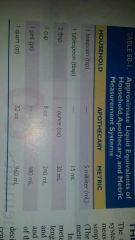![]()
![]()
![]()
Use LEFT and RIGHT arrow keys to navigate between flashcards;
Use UP and DOWN arrow keys to flip the card;
H to show hint;
A reads text to speech;
23 Cards in this Set
- Front
- Back
|
Pharmacology |
Study of chemical substances and their effect on the body. Closely related to mathematics |
|
|
Metric system |
Most common system used in pharmacology. |
|
|
Household, apothecary, metric |

Used in the past, and some are not exact measurement. Caused many confusion and medical errors. |
|
|
Household system |
Used in home. Units are drop, teaspoon, tablespoon, cup, pint, & quart. Replaced by metric system |
|
|
Apothecary system |
Based on volume and wieght. Oldest system, least accurate. Replaced by metric system. |
|
|
Metric system |
Widely used measurment. Generally only measurement used in drug dosage. Based on decimal system based on number 10. Based on meter, gram, liter. |
|
|
Meter, gram, liter. |
M- Measurement of length or distance G- measurement of weight L- measurement of liquid volume |
|
|
Increment of metric system |
Deci- divided by 10 Centi- divide by 100 Milli- divide by 1,000 Micro- divide by 1,000,000 Deca- multiply by 10 Hecto- multiply by 100 Kilo- multiply by 1,000 |
|
|
Conversion |
2.54 cm = 1 in 2.2 pounds= 1 kg 1 Oz = 28.35 grams 16 Oz = 1 pound |
|
|
Unit abbreviation |
Milligram- mg Gram- G Kilogram- kg Microgram- µg Liter- L Milliliter- mL |
|
|
Converting from large to small |
Move decimal point to right. Ex 1g=1,000 mg 1.5g= 1,500 mg For small to large.. move decimal to left. Ex 1,000 mg= 1g 1,500 mg=1.5g |
|
|
Nursing alert |
Safe administration of medication is primary nursing responsibility. |
|
|
Ratio |
Relationship of one quality to another. May be written as fraction or numbers separated by a colon. Ex. 2/3 or 2:3 or 2 is to 3. |
|
|
Proportion |
Consist of two equal ratios separated by an equal sign (=) or double colon (::) Ex. 2/3 = 6/9 2:3 :: 6:9 2 is to 3 as 6 is to 9 2 and 9 are considered extremes, 3 and 6 are means.. |
|
|
Rules to using ratios and proportion 2:3 :: 6:9 |
4 rules... 1) product of means equal product of extremes. 2x9=18 & 3×6=188 2) product of mean divided one extremes equals other extreme.. 3×6=18 18÷2=9 3) the product of the extremes divided by one mean yields other mean. 2×9=18 18÷6=3 4) whatever you do on one side of = must do to other side. |
|
|
Note of dosage |
If dosage for tablet doesn't come out exactly, the prescribe dosage cannot be give . |
|
|
Fraction |
Portion or piece of a whole that indicates division of that whole into equal parts. |
|
|
Common fractions |
AKA simple fraction, have a numerator ( top) and a denominator (bottom) N- refers to a part of the whole. D- total number of parts |
|
|
Multiply fraction |
2/3 × 3×4 (2×3=6) (3×4=12) New value 6/12 or 1/2 |
|
|
Divide fraction |
3/4 ÷ 2/3 Reverse 2/3 to 3/2 New problem 3/4 × 3/2 Solve.. 9/8 or 1 1/8 |
|
|
Decimal fractions. |
Fraction where 10 is always denominator |
|
|
Fórmula method |
Desire / available × quantity =amount to give.
D/A×Q= amount to give Use to calculate dosages in same system & Sam units of measurement. |
|
|
Percentage |
Refers to number per hundred. 20% equal 20 per hundred |

